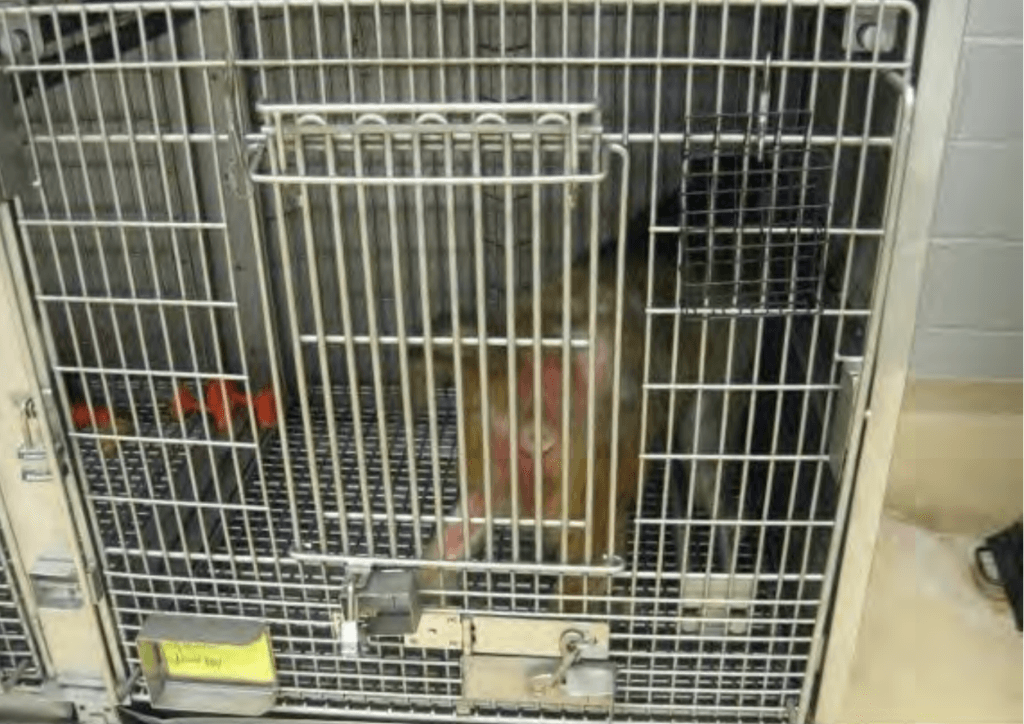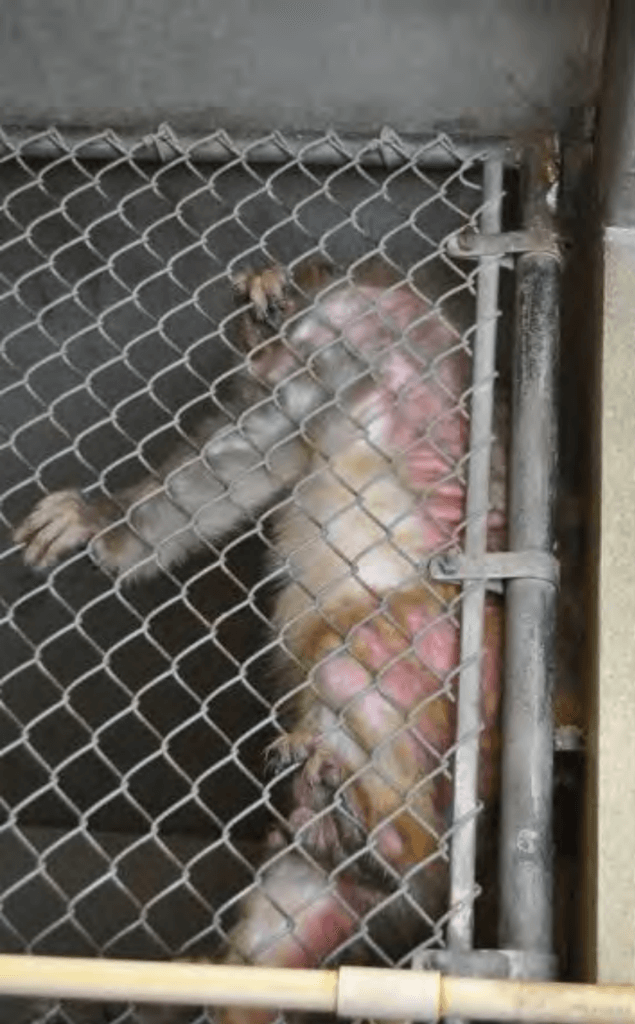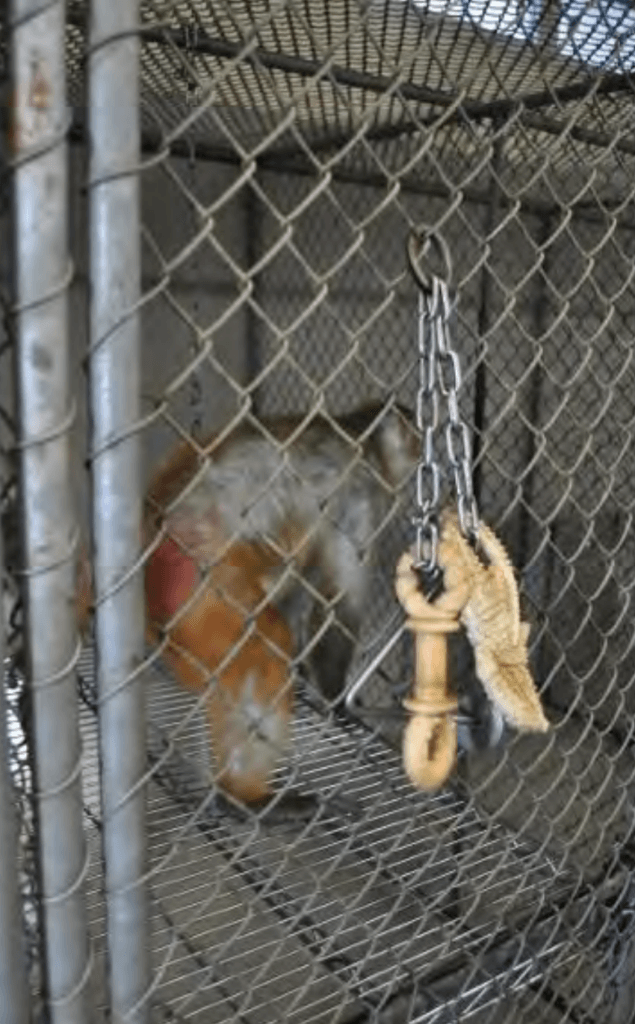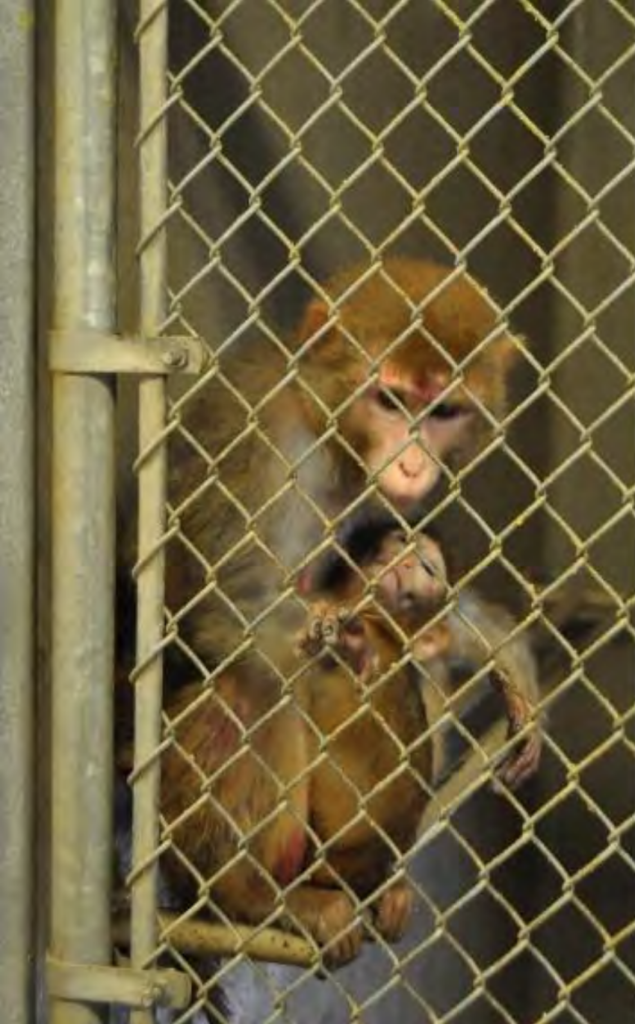USDA Finds Agony for Monkeys at Johns Hopkins
PETA has obtained damning photos from U.S. Department of Agriculture (USDA) inspections of Johns Hopkins University (JHU) laboratories revealing that monkeys are locked in cramped barren cages, apparently driven by stress and a soul-crushing lack of stimulation to tear out their own hair, and left suffering from untreated medical conditions.
The photos, taken by USDA inspectors, document violations of the federal Animal Welfare Act (AWA), which sets the minimum standards for the treatment of animals in laboratories. More importantly, each photo vividly shows that JHU warehouses monkeys and treats them like laboratory tools, rather than viewing them as intelligent, loving animals who are capable of feeling pain, anxiety, and depression and deserve to be free.
Update: December 20, 2023
JHU has violated animal protection laws in its laboratories, and now it has to pay up. The U.S. Department of Agriculture has taken the rare step of fining the university $12,300 for its despicable actions leading to the deaths of numerous animals.
A dog died after experimenters administered potassium chloride to the animal using an incorrect method. Negligent staff allowed a rabbit to become so emaciated after a tumor implantation procedure that by the time anyone noticed, the animal had to be euthanized. Asleep-at-the-wheel staff also didn’t notice that a pig was suffering from broken elbows. That animal was also euthanized. Topping off this list of atrocities, a young monkey escaped from an enclosure and was later found dead in a floor drain.
How desperate does someone have to be to escape their tormentors that they’d attempt to flee down a drain? The National Institutes of Health continues to throw more taxpayer dollars at this house of horrors than at any other university in the country, including more than $1.6 billion in the past two years alone. We’ve urged the agency to shut off this money spigot. You can help by urging JHU to stop tormenting monkeys and other animals—including the sensitive barn owls used in Shreesh Mysore’s horrific brain experiments—in its laboratories by taking action below
Update: December 22, 2021
Following reports this week that the National Institutes of Health has launched an investigation into the Washington National Primate Research Center (WaNPRC) at the University of Washington for apparently failing to keep monkeys free from disease, PETA asked Johns Hopkins University (JHU) to stop buying and using monkeys from the WaNPRC. In addition, we asked JHU to retract any published papers based on experiments using potentially infected monkeys.
JHU experimenters use pig-tailed macaques obtained from the WaNPRC. These monkeys may harbor viruses that make the results of experiments on them meaningless. Unintended infections also threaten public health and safety, waste millions of taxpayer dollars, and cause immense animal suffering.
Take action below to urge JHU to stop tormenting monkeys and other animals—including the sensitive barn owls used in Shreesh Mysore’s horrific brain experiments—in its laboratories.
Update: March 2, 2021
Earlier this month, in response to our public records request, PETA received documents from the Maryland Department of Agriculture stating that Johns Hopkins University (JHU) purchased 31 rhesus macaques in January 2018 from the notorious taxpayer-funded Wisconsin National Primate Research Center (WNPRC). These animals went from one hellhole (WNPRC) to another (JHU), where U.S. Department of Agriculture inspectors have documented repeated violations of the federal Animal Welfare Act.
PETA’s six-month undercover investigation into the WNPRC revealed widespread suffering and neglect. Nearly 2,000 highly intelligent monkeys are kept at the WNPRC, and some have been driven mad by extreme, near-constant, long-term confinement—over two decades for some—deprived of the opportunity to satisfy their most basic needs. One worker said that some of the monkeys can’t be housed with others “because they’re a**holes” to one another in the highly stressful and substandard conditions, leading monkeys to sustain deep, painful lacerations; damage to fingers so severe that they required amputation; and other injuries from attacks. Other monkeys mutilated themselves or paced and circled endlessly, a well-known and dysfunctional method of trying to cope with mental anguish. Some of them pulled out their own hair until they were nearly bald. Many were found to have chronic diarrhea, lasting for months or even years. Cornelius, a monkey who has been at the WNPRC for a decade and was usually kept in isolation, was routinely found hunched over or with his face pressed against the cage bars. As one supervisor said, staff are “not supposed to say” that monkeys “look depressed” but admitted that they absolutely do.
Call on JHU to stop tormenting monkeys and other animals—including the sensitive barn owls used in Shreesh Mysore’s horrific brain experiments—in its laboratories.
Inside JHU …
USDA inspectors found numerous troubling animal welfare violations, including housing monkeys separately in barren cages and allowing them to suffer from untreated medical conditions.
Monkeys, normally gentle, social animals, were kept separated, alone in empty metal cages barely large enough for them to turn around in, with nothing to make their lives worth living.

Normally social monkeys are caged in isolation at JHU, a situation causing them undue stress and mind-destroying frustration, which sometimes results in hair loss, as seen in this monkey.
The gentle monkey pictured above, who doesn’t even have a toy to play with as a distraction from the unrelenting loneliness, suffers from alopecia, a condition that results in hair loss. The monkey may also be tearing his or her own hair out as a result of the stress of confinement and the absence of peers with whom to engage in mutual grooming, which is what monkeys do in exchange for food, sex, and friendship.

This is another gentle monkey at JHU whose hair has almost completely fallen out. The only hair left is on the head and wrists.
Kept in these austere settings, monkeys may suffer from psychological trauma. They often pace, pull out their own hair, and bite themselves in a desperate attempt to experience any kind of stimulation in their utterly deprived lives.

Another monkey at JHU, alone in a barren cage, is suffering from hair loss.
Monkeys caged alone, as USDA inspectors have photographed in JHU labs, tend to exhibit “stereotypic behavior,” such as repetitive movements like pacing, circling, swinging, and rocking, to alleviate their mental anguish and to try to cope with their inadequate environment.

This monkey is overweight and has severe alopecia. Inspectors noted that JHU had no plan to treat either problem—she was simply left to suffer with her baby in a barren cage.
The public deserves to know what takes place behind the locked doors of JHU’s laboratories, where experimenters conduct crude animal tests, often receiving taxpayer funds for them. PETA is fighting to shine the bright light of public scrutiny on these experiments. We have known for decades that monkeys need companionship, access to outdoor spaces, and much more than a laboratory can provide.

This is another shot of the monkey and her baby, both suffering from severe alopecia, which JHU apparently ignored. There was no treatment plan for either monkey.
JHU’s repeated failure to comply with the AWA is deplorable. Below are just some of the university’s recent violations of federal animal welfare regulations, as noted by the USDA.
- February 28, 2023: A dog went into cardiac arrest and died after experimenters administered potassium chloride to the animal using an incorrect method.
- September 27, 2022: A rabbit was allowed to become emaciated after being subjected to a tumor implantation procedure. Experimenters failed to document the most basic markers of distress, including poor appetite, so the animal was never provided with veterinary care. By the time negligent staff realized that the rabbit was ill, the animal had become too sick and was euthanized.
- August 23, 2021: Monkeys who were subjected to cranial implant surgeries, in which their skulls were cut into, suffered chronic implant infections. The experimenter killed half of them because of negligent and unsterile surgical techniques.
- August 23, 2021: Laboratory staff failed to provide pigs used in experiments with necessary pain relief.
- August 23, 2021: A pig subjected to a heart experiment had to be killed when both his elbows were found to be broken, which supposedly happened as he moved from one area to another. A laboratory staffer failed to inform veterinary personnel after observing that the pig was unable to stand. Instead, the staffer left the injured animal to suffer.
- June 10, 2019: A marmoset died after a laboratory worker closed the cage door on him or her, causing hemorrhaging and trauma to the neck.
- February 15, 2017: A young macaque was found dead in the outdoor portion of her enclosure. Her head had become caught inside a ball used for enrichment, which had a hole chewed into it sufficient to allow her entire head to become entrapped. Although the necropsy was not conclusive, the facility determined that the cause of death was likely prolonged exposure to the cold combined with the stress of not being able to free her head.
- July 15, 2016: JHU failed to ensure the psychological well-being of primates. Eight primates were noted to have significant hair loss at the time of inspection. Some of them were not given adequate treatment.
- July 12, 2016: Two baboon cages had loops of water lines entering from the top, creating a possible strangulation hazard; two racks of rabbit enclosures had water nipples that did not fully reach into the cages, making it difficult for the animals to access fresh water; three primates were singly housed and had no visual contact with peers; and there were 17 instances of expired medications.
- January 28, 2015: A rabbit died of asphyxiation after being left in a cage that was sent through a high temperature disinfecting machine prior to regular cage washing.
In addition to violating the federal Animal Welfare Act, JHU has been busy breaking a set of rules—known as the Public Health Service Policy on Humane Care and Use of Laboratory Animals—that experimenters must abide by if they receive federal funds.
- September 11, 2022: Experimenters allowed a rabbit used in a set of cancer experiments to suffer with a “tumor burden in the liver [that] had exceeded the [designated] humane endpoint.” The aggressive tumor had metastasized to the lungs, and a veterinary resident found the rabbit in severe distress.
- September 11, 2022: Rabbits who had been subjected to traumatic brain injuries experienced postoperative complications after a surgical procedure. The incision made in one of the rabbits had burst open at the skull. A second rabbit developed an infection at the surgical site, and a third developed neurological issues so severe that they necessitated euthanasia. Attending veterinarians discovered “poor aseptic technique during surgeries.” (Translation: Negligent experimenters performed the surgeries in a germ-laden manner.) As if that weren’t bad enough, the experimenters failed to provide the rabbits with sufficient postoperative care.
- June 12, 2022: A pig used in a cardiac experiment underwent testing procedures after the protocol had expired, and the experimenter failed to submit a renewal application. This constituted a “serious noncompliance” of the Public Health Service Policy on Humane Care and Use of Laboratory Animals.